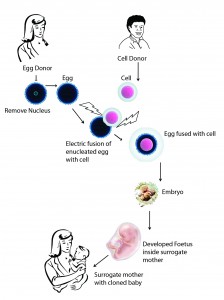Cloning is defined as “the technique of producing a genetically identical copy of an organism by replacing the nucleus of an unfertilized ovum with the nucleus of a body cell from the organism”. The first animal that was cloned successfully was a sheep and it was named Dolly in 1997. The cloned sheep, Dolly was exactly similar to the naturally conceived sheep. The only difference between the two was: Dolly’s embryo was developed without the presence of sperm.
Dolly’s birth has brought a marked revolution in the genetic engineering technology. Over the years scientists have duplicated many non-human animals like mice, pigs, cows, dogs, monkeys etc. The research has extended to human cloning, but since years human cloning technology has remained in infant stages as there are many ethical concerns involved. Let us discuss how human cloning is done and what are the steps involved in it.
Human cloning can be of two types, namely Reproductive cloning and Therapeutic cloning. Reproductive cloning is done to duplicate a human to his/her offspring who exactly resembles his/her parent. Therapeutic cloning is done to grow stem cells from the embryonic clone.
Reproductive cloning:
Reproductive cloning makes use of somatic cell nuclear transfer (SCNT) technique to develop the embryo. This technique involves the donation of egg cell with nucleus from the female donor. The nucleus of the egg cell is removed creating an enucleated egg. The person who is being cloned acts as somatic cell donor. The somatic cell should contain DNA as its genetic material. The somatic cell is fused with the enucleated egg in artificial medium using electricity. The high voltage make pores in somatic cell membrane and facilitates the infusion of egg cell in to the somatic cell. This results in formation of embryo.
The embryo, is then implanted into the surrogate mother’s uterus for gestation. At the end of gestation period, the surrogate mother gives birth to the cloned baby of the cloned subject. But usually the success rate for this procedure is very less and only one or two out of 1000 embryos would reach the world.
There were many fabricated publications about the successful human cloning. Many scientists reported that they have cloned human embryos but later it was proved to be fabricated work. Till date there are no proven records of successful human cloning.
Therapeutic cloning:
The main aim of therapeutic cloning is to develop stem cells from the cloned embryos which would help in treating many diseases/disorders. It also assists in organ replacement therapy. The procedure involved is similar to that of SCNT, but instead of inserting the embryo into surrogate mother, its cells are used to grow stem cells. These stem cells are used for the respective therapies.
Currently in India, gene cloning is in infant stage and hope this technique would excel in India and creates a therapeutic platform for many untreatable diseases and disorders in near future.


